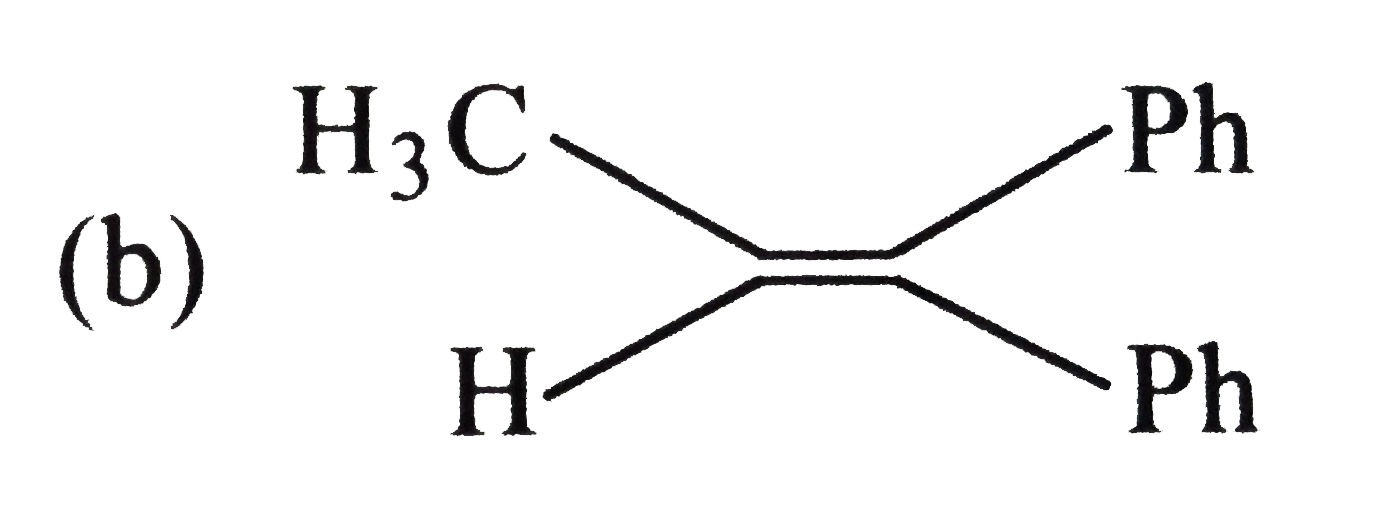A tertiary alcohol upon acid catalysed dehydration gives a product I. Oronolysis of I leads to compounds J and K. Compound Jupon reaction with KOH gives benzyl alcohol and a compound L, whereas K on reaction with KOH gives only M.

The structure of compounds I is




The correct Answer is:A
Ph−OH∣C∣CH3−CH2PhH+,Heat−−−−−→−H2OPh−C∣CH3(I)=CHPh
Topper's Solved these Questions
- ALCOHOLS, PHENOLS AND ETHERSBOOK - MODERN PUBLICATIONCHAPTER - ALCOHOLS, PHENOLS AND ETHERSEXERCISE - OBJECTIVE TYPE QUESTIONS (MULTIPLE CHOICE QUESTIONS)(matching lisy type questions)
2 Videos
- ALCOHOLS, PHENOLS AND ETHERSBOOK - MODERN PUBLICATIONCHAPTER - ALCOHOLS, PHENOLS AND ETHERSEXERCISE - OBJECTIVE TYPE QUESTIONS (MULTIPLE CHOICE QUESTIONS)(Integer Type or Numerical Value Type Questions)
7 Videos
- ALCOHOLS, PHENOLS AND ETHERSBOOK - MODERN PUBLICATIONCHAPTER - ALCOHOLS, PHENOLS AND ETHERSEXERCISE - OBJECTIVE TYPE QUESTIONS (MULTIPLE CHOICE QUESTIONS) (with more than one correct answer)
10 Videos
- ALDEHYDES ,KETONES AND CARBOXYLIC ACIDSBOOK - MODERN PUBLICATIONCHAPTER - ALDEHYDES ,KETONES AND CARBOXYLIC ACIDSEXERCISE - UNIT PRACTICE TEST
13 Videos
Similar Questions
A tertiary alcohol (H) upon acid-catalysed dehydration gives a product (I). Ozonolysis of (I) leads to compounds (J) and (K). Compound (J) upon reaction with KOH gives benzyl alcohol and a compound (L), whereas (K) on reaction with KOH gives only (M).

The structures of compounds (J), (K), and (L), respectively, are:
View SolutionA tertiary alcohol (H) upon acid-catalysed dehydration gives a product (I). Ozonolysis of (I) leads to compounds (J) and (K). Compound (J) upon reaction with KOH gives benzyl alcohol and a compound (L), whereas (K) on reaction with KOH gives only (M).

The structures of compounds (J), (K), and (L), respectively, are:
View Solution
Knowledge Check
A tertiary alcohol H upon acid catalysed dehydration gives a product I. Ozonolysis of I leads to compound J and K. Compound J upon reaction with KOH gives benzyl alcohol and a compound L, whereas K on reaction with KOH gives only M.

The structure of compound I is :A B
B C
C D
D
A tertiary alcohol H upon acid catalysed dehydration gives a product I. Ozonolysis of I leads to compound J and K. Compound J upon reaction with KOH gives benzyl alcohol and a compound L, whereas K on reaction with KOH gives only M.

The structures of compound J, K and L respectivley are :A B
B C
C D
D
A tertiary alcohol H on acid catalysed dehydration gives a product I. Ozonolysis of I leads to compounds. J and K . Compound J upon reaction. With KOH gives benzyl alcohol and a compound L, whereas K on reaction with KOH gives only. M

The structure of compound I is :A B
B C
C D
D
A tertiary alcohol H upon acid- catalyzed dehydration gives a product I. Ozonolysis of to compounds J and K. Compound J upon reaction with KOH gives benzly alcohol and a compound L, whereas K on reaction with KOH gives only M.

The structure of compound I is
View SolutionA tertiary alcohol H upon acid- catalyzed dehydration gives a product I. Ozonolysis of to compounds J and K. Compound J upon reaction with KOH gives benzly alcohol and a compound L, whereas K on reaction with KOH gives only M.

The structures of compound J,K and L respectively , are
View SolutionA tertiary alcohol (H) upon acid-catalysed dehydration gives a product (I). Ozonolysis of (I) leads to compounds (J) and (K). Compound (J) upon reaction with KOH gives benzyl alcohol and a compound (L), whereas (K) on reaction with KOH gives only (M).

The structures of compounds (J), (K), and (L), respectively, are:
View SolutionA tertiary alcohol (H) upon acid-catalysed dehydration gives a product (I). Ozonolysis of (I) leads to compounds (J) and (K). Compound (J) upon reaction with KOH gives benzyl alcohol and a compound (L), whereas (K) on reaction with KOH gives only (M).

The structurer of compound (I) is:
View SolutionA tertiary alcohol (H) upon acid-catalysed dehydration gives a product (I). Ozonolysis of (I) leads to compounds (J) and (K). Compound (J) upon reaction with KOH gives benzyl alcohol and a compound (L), whereas (K) on reaction with KOH gives only (M).

Compound (H) is formed by the reaction of:
View Solution
